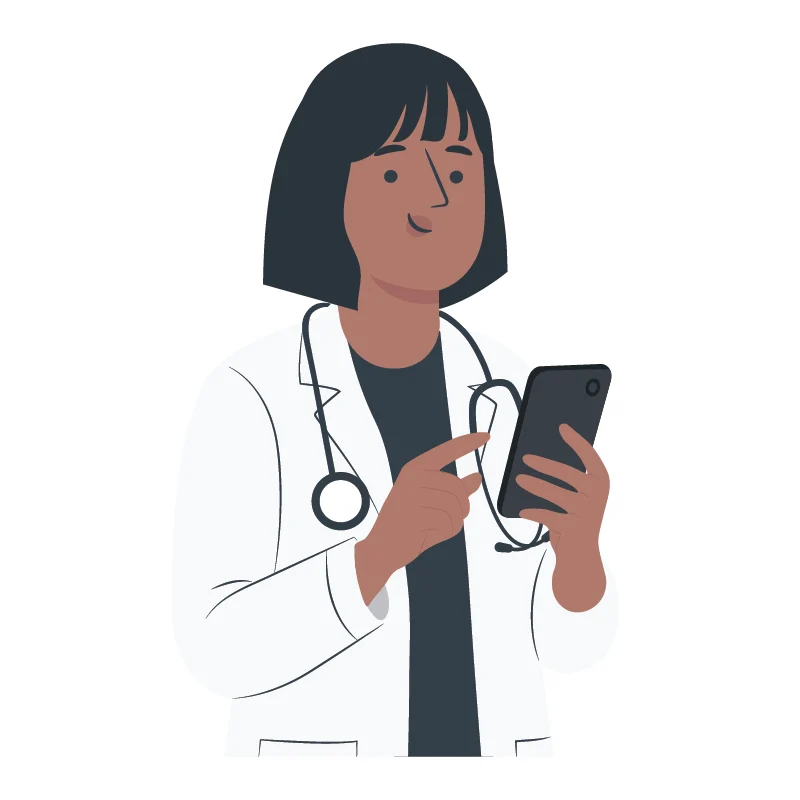Event Replay
A Roadmap for Change Management Projects
Watch NowTABLE OF CONTENTS

A nurse begins his shift at 7 AM. He clocks in and gets his schedule on a printed sheet, plus a handful of sticky notes with some overnight shift change updates.
His first stop is checking voicemails on the shared phone. A patient’s light is already blinking: he needs an extra blanket. Another light starts blinking before he can finish charting the last patient visit.
By mid-morning, a critical lab result sends the nurse scrambling to find the right physician, only to discover the call schedule is outdated. By noon, he realizes a consult request from earlier in the day was never addressed. At 2 PM, he’s on hold with the pharmacy and tracking down a patient’s family. His day ends with manual notes, follow-up calls, and another delayed handoff.

It’s not just the outdated workflows slowing him down and wearing him out. It’s the patchwork of disconnected systems; the very tools meant to make his job easier are instead adding more work.
So how do you calm the chaos? The answer is technology. But unlike this poor nurse whose problems are being made worse by disconnected systems, healthcare organizations need fit-for-purpose solutions that are intuitive to use, interoperable with other systems, and actually make the nurse’s job easier.
When information flows where it needs to, nurses and other clinicians can focus less on chasing messages and more on patient care. Here’s how technology can drastically improve both care team communication and patient outcomes.
Technology can make life on the floor far easier, but only if it’s the right kind.
“Over the past decade, providers have grown increasingly frustrated by the amount of documentation required—not just for care delivery, but largely to support accurate billing,” says Kelly Conklin, Chief Customer Officer & Chief Clinical Officer at PerfectServe (and former CNO). “The number of clicks, the time spent at a computer, and the effort involved in managing schedules all take them away from what they love most: patient care.”
Clinical communication technology, in particular, has the potential to massively improve the day-to-day experience of healthcare staff. But done wrong, it can also make things much harder. That’s why nearly half of all malpractice claims involve a breakdown in communication.1 The right tools can prevent those miscommunications and the resulting legal fallout.
This is what healthcare technology should be doing: getting out of the way so nurses and clinicians can do their jobs. They need to be able to:
Even hospitals that have embraced a modern tech stack risk swamping nurses and clinicians with too many apps and inboxes. And when the approved channels don’t work well or are simply too confusing, clinicians may opt to communicate with one another by SMS text using their personal devices. That’s a quick way to end up outside the bounds of HIPAA compliance.
To make a noticeable difference in the lives of hospital staff and patients, healthcare communication systems should offer the following key capabilities:
Targeted coordination: always know exactly who to reach
Prisma Health found that their clinicians were wasting more than 28 hours collectively during every shift attempting to communicate with one another.
While the exact causes vary, one common culprit in many hospitals is the difficulty of figuring out who to contact. Why? Because schedules are often handled in static spreadsheets or even printouts.
“Just because this schedule got printed at 7 AM doesn’t mean that Dr. Smith didn’t trade off with Dr. Jones at 10 AM, and now you’re contacting the wrong person,” says Michelle Green, a Customer Success Manager at PerfectServe. “You struggle to quickly connect with the right provider. In urgent situations, such as traumas, strokes, and codes, confusion can cost precious time.”
If you introduce more sophisticated routing, figuring out who’s on call can be a breeze. Imagine being automatically connected to the right person who can take action at any given moment. Let’s play it out.
Say a nurse receives a critical alert about a patient’s abnormal potassium level. He needs to reach the hospitalist immediately, but the doctor is currently with another patient.
A communication platform with integrated schedules, rule-based routing, and escalation capabilities can take this alert and automatically forward it to the backup on-call specialist if the original message goes untouched for, say, 2 minutes.
There’s no delay in care, and the hospitalist still receives a notification, so she’s informed of the result and can follow up when she’s available.
Patient-centered access: All you need to know is the patient’s name
Coordinating a large team of providers can quickly turn into a nightmare, particularly in urgent care. “When those traumas come in, there’s literally 40 people at that bedside,” Michelle says. “It’s a lot to get 40 people coordinated in a room at the same time.”
When there’s no centralized, real-time view of who’s assigned to each patient, even simple tasks become a series of frustrating workarounds—calls, pages, maybe even a frantic dash or two down the hallway to wrangle the right people. Multiply that across a full shift and a dozen patients, and the delays can add up fast.
Now picture this instead: You type in the patient’s name and immediately see every member of the current care team—hospitalist, cardiologist, nurse, care coordinator, physical therapist. You can message any of these people individually, or even contact the whole care team: “Hey, did you know that Sally gets to go home today as long as everybody signs off on it? Please put your discharge orders in.”

This also makes it far easier for providers to connect with nursing staff.
Say a clinician wants to check on the post-op urine output of the patient in Room 821. With more rudimentary communication methods, they might have to call the floor, ask who’s assigned to 821, wait for someone to track that down, and then hope the nurse is available to take the call.
With better communication tech, they can quickly see who’s assigned and send a direct message. In fact, they might have an answer for their question in less time than it took to make one phone call using the previous method.
Multichannel communication: One inbox to check
If communication is all over the place—voicemails, pagers, mobile phones, sticky notes—then nurses and physicians are forced to waste time switching between apps, devices, and even the department whiteboard, making mistakes and delays much more likely.
A multichannel communication platform brings everything together by unifying all devices (smartphones, web browsers, landline phones, VoIP devices, pagers) and communication methods (text, call, video).
No more juggling devices and apps. You have all the information you need in a single, integrated inbox.
Responsive escalation: No more dropped messages
Communication failures are a significant safety issue: A study by the Joint Commission found that 80% of serious medical errors involve miscommunication between caregivers, particularly during patient handovers.
Without the right tech in place, messages get dropped all too easily. Maybe a voicemail sits unheard in a mailbox that rarely gets checked. Maybe another message is delivered to the right physician, but it gets lost among the 15 other messages she received in the past hour because she can’t tell what’s urgent and what can wait.
To take a real-world example:
One major orthopedic hospital requires staff to get live verbal confirmation that the provider has received a lab result. Depending on the provider’s availability, that could mean minutes or hours of delay.
If the ordering provider was off shift, the lab would check the on-call schedule and start again. This was frustrating for staff, who were often juggling multiple important patient matters at one time, and risky for patients, whose critical results might not reach the right provider in time.
By contrast, a healthcare communication system with responsive escalation ensures that the message always reaches the right person. If the first stop doesn’t get a quick response, the message will be escalated based on your pre-defined criteria.
“If I’m a nurse and I reach out, I don’t have to worry about Dr. Smith not getting back to me in 20 minutes,” explains Michelle. “I know that message is going to escalate.”
You’ll also be able to see who it went to, when it was delivered, and if it was read.
At the orthopedic hospital, a project to overhaul the communication pathway for the delivery of critical lab results led to a 42% improvement in how quickly results were acknowledged. The backbone of this process? A clinical communication platform with intelligent routing.
And this isn’t just about delivering better, more timely patient care—it’s also about protecting your organization. With a more capable clinical communication system, you have a verifiable record of who received, acknowledged, and responded to each message.
If a question comes up about a patient’s treatment after the fact, an auditable communication trail can pay dividends. Sticking with critical lab results, let’s say positive blood cultures were returned for a patient. In the event of litigation, imagine being able to show that the result was received in the lab system, promptly delivered to the physician’s inbox, immediately acknowledged, and quickly acted upon—with documentation that includes a message from the physician reading, “On my way. Just saw positive blood cultures.”
That’s communication that removes roadblocks for clinicians, keeps patients safe, and protects your organization all at once.
When messages land where they’re supposed to and the right people stay in the loop, everyone’s job gets easier. Most importantly, patients get the attention they need.
But that’s not always how things work in healthcare organizations. It’s time to ask yourself:
If any of those problems hit a little too close to home, it might be time to consider technology that turns communication into a highly reliable process—not a constant roadblock.
Sources